This article derives from a presentation from the Masters of Product Marketing event in October 2022. Catch up with all content with our OnDemand platform. For more exclusive content, visit your member dashboard.
Hi, everyone. My name is Tracy Montour, and I'm currently the Director of Product Marketing at HiredScore, an AI HR technology company.
When I joined HiredScore, it was an eight-year-old company serving 40% of the Fortune 100 and had never had a product marketer before. I knew I would be drinking through the firehose but also that it would be a massive opportunity – it's not often you get to build something from the ground up.
As a product marketer, I love taking something complex and making it simple and digestible. You can not only do that with messaging and positioning, but you can do that internally with your processes as well.
That doesn't mean it's not hard, but if you're like me, you want to make a strategic impact in your career, not just do tactical work. We became product marketers to drive impact, accelerate revenue, and even change the way that people think, work, and live.
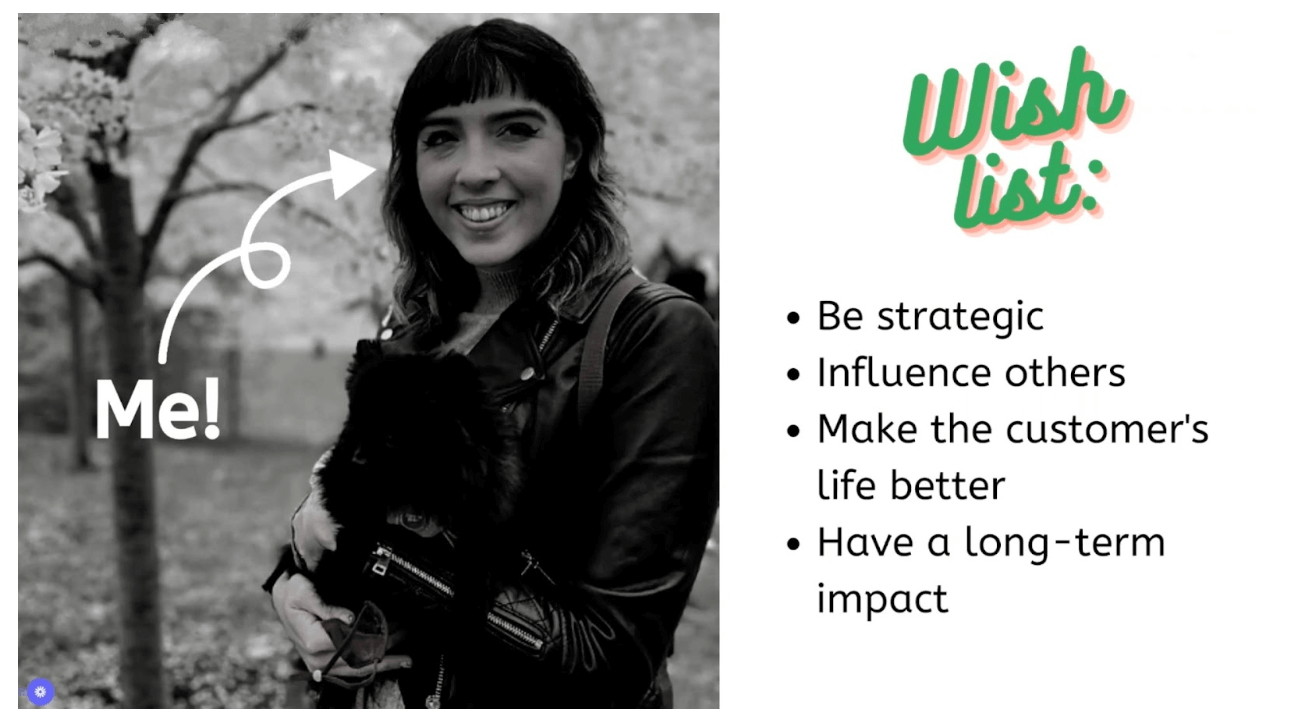
It's so easy as the sole or first product marketer in an organization to turn into the person that everyone goes to for all their one-pagers and slides.
Eventually, you find yourself being bombarded with these small tasks, and they take up so much of your mental bandwidth that you burn out and can’t work on the strategic tasks that are required to drive change – the work that we all became product marketers to do.
According to the Product Marketing Alliance, 21% of product marketers are doing it alone. That's a really tough place to be, and I've been there. Maybe you're there now. Maybe that’s even where you want to be. Well, you're in luck. I'm going to share some best practices to help you set yourself and your future team up for maximum impact.
We're going to discuss my three favorite things:
- Foundational strategies
- Cross-functional alignment
- Processes
Yes, as you can guess, I am super fun at parties.
Be the air traffic controller for your organization
Product marketing tends to be chaotic and full of ambiguity, which is part of the fun. We love problem-solving and making sense of complex issues.
We get to work with so many stakeholders and be at the center of everything that goes on within the organization. All of this is amplified exponentially when you're building the function from the ground up.
Some people say it's like building a plane while you're flying it, but that analogy doesn't really resonate with me.
What if the other departments already have their planes built? What if one department’s flying a paper aeroplane while another’s in a fighter jet? What if they're all flying at different speeds? What if every department is taking a completely different route to the same destination?
To be seen as strategic from day one, it’s mission-critical to be the internal air traffic controller for your organization, but what does that mean? Well, as the internal air traffic controller, it's important to balance three key things:
✈️ Position,
✈️ Speed, and
✈️ Altitude.
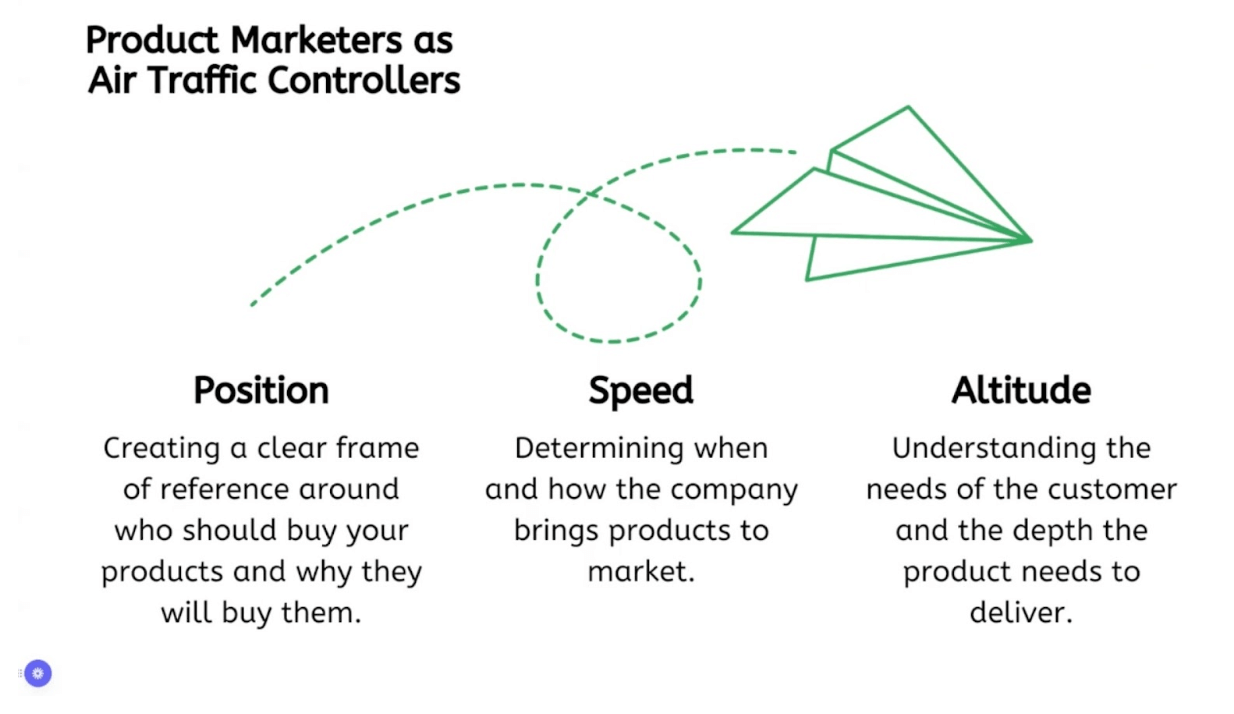
Positioning is our number one priority. We need to create a clear frame of reference around who should buy our products and why they should buy them.
We need to deeply understand the triggers, challenges, motivations, and daily frustrations of our personas, and we need our external message and product value to make this promise and deliver on it. This is a big ask, and it's our number one priority.
We also need to manage the cadence of how and when the company brings products to market. We can't land all the planes at once – that won’t be effective.
We also can't land a plane every minute which causes fatigue. We need to coordinate launches and landings for maximum impact and ensure we align the customer and the business needs and expectations.
This is where altitude comes in. As product marketers, we need to understand the needs of the customer more deeply than anyone else in the company.
We need to be the voice of the customer within the organization to ensure we are communicating and building the right products at the right depth to provide value and ensure business health.
Altitude also has to do with our messaging. How deep do we go? How complex do we go? How do we appeal to the frustrations or desires or gaps in our customers’ daily lives? As I said, this is mission-critical.
Step one: All great work starts with a process
Now, this probably isn't what you want to hear, but all great product marketing work starts with a process.
There are many buckets of important processes, but the three that I believe to be critical when building a product marketing function from the ground up are stakeholder processes, functional processes, and prioritization processes. Let’s take a closer look.
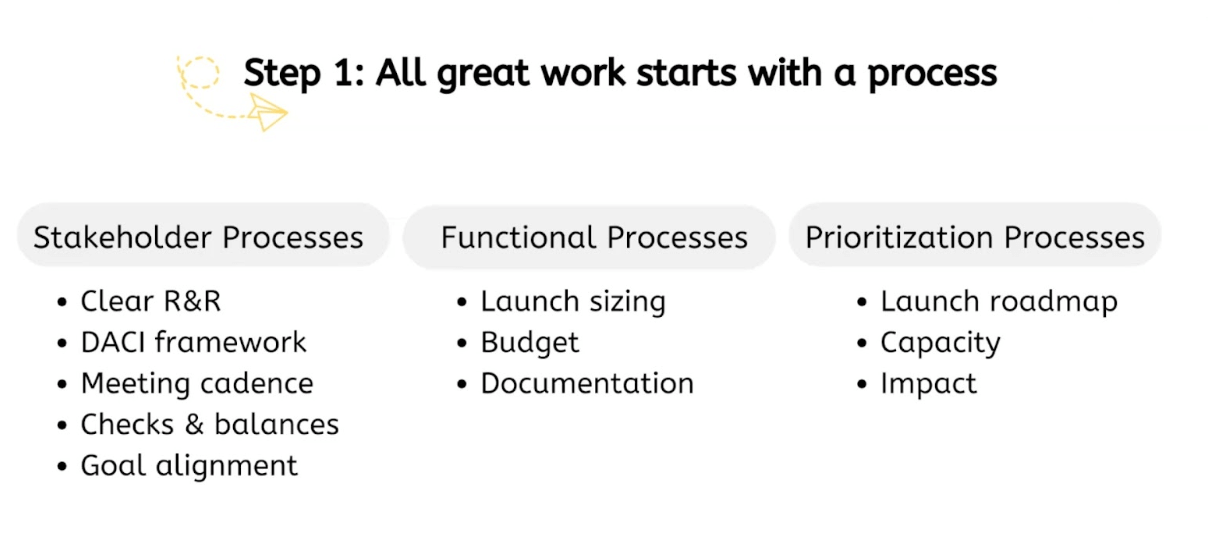
Building clear stakeholder processes
Managing stakeholder relationships and expectations is essential to success, especially if you’re the first product marketer in an organization.
Product marketing looks different in every company, and people need to understand how to work with you, what your version of product marketing looks like, and how you can best help the business, so the ability to influence is one of the most impactful skills a product marketing leader can have.
Depending on how your organization works, the types of relationships you have to manage may be different, but product marketers usually need to build relationships between sales, marketing, customer success, product, and the customer. The customer is your number-one stakeholder and should be built into every process you establish.
Building relationships with stakeholders takes time – you're not just going to come in and have everybody trust you 100% to do whatever you want. You need to establish credibility and build trust first. Setting regular meetings with your stakeholders will allow you to build the meaningful and trusting relationships you need.
These meetings are not just about work and upcoming projects, but also about getting to know your stakeholders and understanding their motivations.
Think about your stakeholders as you think about your personas and buyers. How can you influence them and appeal to what they care about? You have to give a damn about what they're working on and try to help them achieve their goals.
The most effective cross-functional relationships have clear roles and responsibilities. People have to understand how you and your team can help them, so guide your stakeholders and teach them how to use you.
In my role at HiredScore, for example, I have a "How to work with product marketing" deck, which I take all new employees through. This eliminates any guesswork, and they can check back at any time to understand how best to work with the product marketing team and get more value out of them.
A framework like DASI, which stands for Driver, Approver, Contributor, and Informed, can also be used to establish clear roles and responsibilities when working on cross-functional projects.
When working cross-functionally, it’s essential to establish boundaries. In small organizations, there may be times when you have to step outside of those boundaries, but it's important to have a frank discussion when those boundaries are at risk and get alignment on who's handling what and why.
As you align your work with others, you should also keep in mind that it's important to align around the same goals without over-indexing on one stakeholder.
It's critical to have checks and balances within your process. That means you need to find common ground among the stakeholders you manage.
I often find that product marketers are the best at building consensus because we have exposure to so many different areas of the business and can quickly point out incongruencies and points of contention with an objective lens.
We're outside a lot of the action, so we can come in and give our objective view of the situation and help people figure out how to navigate it. Don't be afraid to do this – it’ll only help make your company stronger and build your credibility.
One of my favorite approaches is to have individual meetings with stakeholders prior to a larger alignment meeting. Now, I know you're probably cringing at the thought of more meetings, but, I do really find this impactful.
Because I spend time digging into their concerns, challenges, and objectives, I'm aware of everyone's agenda going into the larger meeting, and I can steer us towards an outcome that benefits everybody.
It's like a game of chess: you need to understand the whole chessboard so that you can coordinate the moves. It also helps stakeholders and executives feel like product marketing is listening to their needs and concerns and helping to advance their initiatives.
At the same time, I believe in the obligation to dissent. Don't just move other people's initiatives forward if you don’t agree with them, or – even worse – say you will do so if you don't plan on doing it. If you strongly disagree with something you need to say so.
Authenticity is so important for building relationships, especially virtually, but make sure you share your disagreements privately with your stakeholders and make space for candid conversations. That way, they’ll feel comfortable coming to you as a trusted adviser.
Establishing functional launches processes
Next, we have functional processes – definitely not sexy, but definitely necessary. The functional processes you need to build will depend on your organizational set-up and the way you work, but most product marketing organizations will need repeatable processes for launch sizing, budget, and documentation.
Let’s take a closer look at launch sizing. You'll need to outline what types of launches you support as a product marketer and how you'll support them. Help your stakeholders understand what the process is for a small feature release versus a new product launch.
What expectations should they have? How will you communicate and collaborate? Lay all this out and get alignment on the process.
Be open to feedback and adapt the process as you learn and grow. People tend to get frustrated or feel misunderstood when they're not part of the process or they don't know what to expect.
With this in mind, you’ll want to lay out, for example, when you'll enable your sales team, and the expectations for internal and external communication.
Functional processes like this give the organization confidence in you and your team by eliminating ambiguity.
Not only can your cross-functional stakeholders be confident that they know what's coming, but they’ll also have a shared lens through which to evaluate, plan, and align around the work that product marketing is doing.
Prioritization processes
Lastly, prioritization processes are critical. If you're a team of one or part of a small team, there's absolutely no way you can tackle all the work that needs to be done. You need to make this known to your organization and prioritize with a critical lens.
Get alignment with your stakeholders on the work that will drive the most impact, help them understand how the work you're doing will help them meet their goals, and communicate this often. People need to know what's going on, and as long as you're proactive about prioritization, they’ll feel competent in your abilities.
You need to make sure your stakeholders are bought into not only this process, but the work that you're going to be doing. If you include their ideas and inputs in your roadmap while also maintaining your own strong point of view, that work will be all the better and you’ll have the foundations of a strong relationship.
Golden rules for building strong processes
You may have noticed a common thread across all three of these buckets – they all involve getting alignment early and often.
Stakeholder alignment will build your credibility and establish trust in your processes, which then allows you to scale and focus on strategic work.
Here are a few more golden rules to keep in mind, no matter what type of process you’re building:
- Communicate your processes
- Get alignment early and often
- Make others' needs feel heard and addressed
- Be clear about your priorities
- Tie your work back to company objectives
- Most importantly, don't promise to do everything – focus on the work that will have the most important impact on the business and help people to understand why.
Step two: Help people speak the same language
As product marketers, we spend a lot of time getting people outside of the company – our customers, analysts, and partners – to understand what we do.
We do that by making sure we’re speaking their language. But what happens if not everyone is speaking the same language internally? How can we fix that in order to drive alignment?
Well, first, you have to be a listener. This is much simpler when you first join an organization because you don't have any blind spots. You can listen objectively and bring a fresh perspective to the organization.
Whether you've been there five years or five days, put on your external hat, listen to all the challenges each department is going through, and then agree on goals that the whole company can work towards.
Every team is going to approach these goals differently, but if CS is going in one direction, sales are going in another direction, and marketing is going in a different direction entirely, that is a big challenge.
Since product marketers work so cross-functionally, there's never a time when our goals don't influence another team's goals. That means we can help get every team flying in the same direction by showing how we’ll help them win.
You'll also want to communicate often. I'm an over-communicator, and I think that's critical in product marketing because of our strategic cross-functional impact within the organization. We’re exposed to every department’s challenges and goals, and being able to communicate those to other stakeholders is vital.
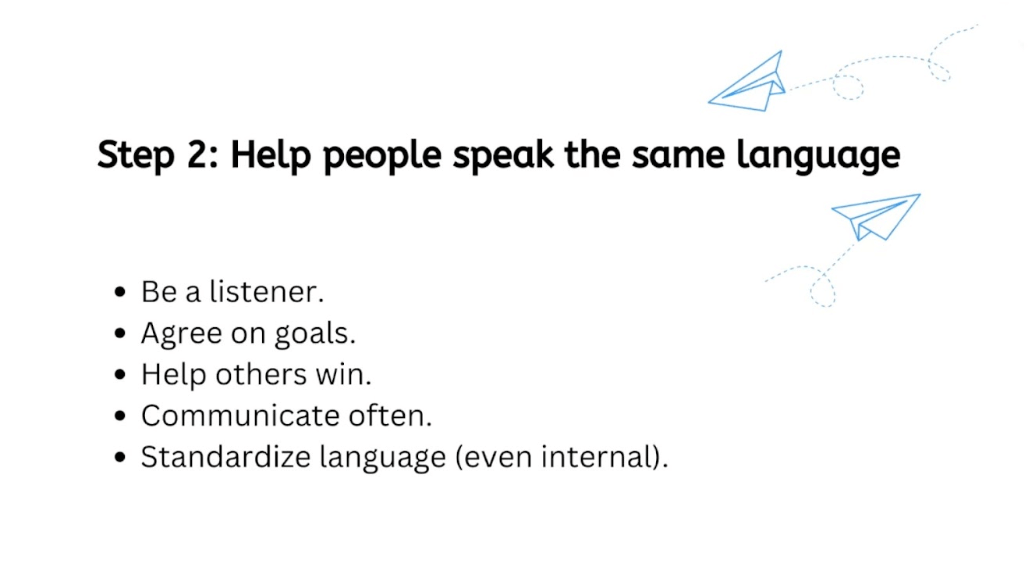
As well as the meetings that we’ve already discussed, your communication can also come in the form of a newsletter, Slack messages, or even setting office hours when people can come and chat with you.
Whatever mode of communication works best for your company, do it, and do it often. People will tell you if it's too much, but that’s rarely the case – people love information, and giving them access to it helps them speak the same language and get on the same page.
A crucial and more literal way to get people to speak the same language is to standardize language internally.
When people call the same things different names, that can lead to huge miscommunications – people may be talking about the same exact thing without knowing it. One way to combat this is to make a Confluence page with agreed-upon definitions of all your internal words. It’s that simple.
When everyone’s speaking the same language internally, that will translate externally as well. This is going to make your life a lot easier when communicating with customers, analysts, and prospects.
Step three: Build for scale
Last but definitely not least, we need to build for scale. That means building repeatable processes.
Not every process is going to work right away – you might build a process and find out it's totally wrong for your organization, but that doesn't mean you should abandon the process and do everything ad hoc every time.
That's not going to allow you to scale, you’ll wind up spending the majority of your time being a project manager, and you’ll get burnt out.
To avoid this, you need to spend some time building repeatable processes. Then try them out and then debrief with your team when something needs to change or be rebuilt.
That way, you’ll end up with a process that’s tailor-made for your organization and people will feel that it’s always evolving to become more efficient and effective.
That being said, when organizations are growing quickly, it's critical to take a step back from your processes every so often to see what needs to change now that you have 100 more employees.
Processes that worked well when you were in a smaller organization might not work so well as you grow. If that’s the case, it’s time to adjust.
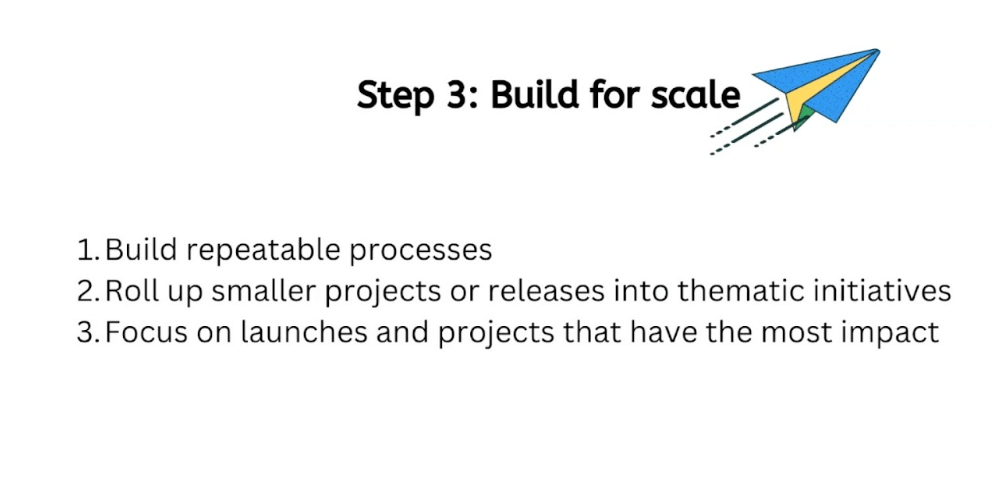
Another crucial part of building for scale is rolling up smaller projects and feature releases into thematic initiatives. This will save you so much time.
Plus, you’ll make the most of people’s short attention spans by bundling smaller launch communications and making sure people internally and externally understand why they’re relevant.
Lastly, you want to optimize your resources. As I said, if you're a team of one, there's no way you can get to everything. We all have limited bandwidth and resources, so we need to focus our efforts on the launches that will have the most impact.
Promoting every launch at the same level results in fatigue across the board and is not effective. Instead, make sure you're being loud around the high-impact launches.
Even in a team of one, you’re not alone
Being a product marketer often comes with a lot of ambiguity and pressure, as well as a lot of exciting opportunities.
Before I wrap up, I want to remind you that you're not alone – everyone's figuring out how to be a strategic product marketer in their own way, and groups like the Product Marketing Alliance are here to help.
I hope this article gave you some inspiration and clarity, and I'm looking forward to seeing what you do next.
Want more leadership insights?
Continue the conversation and network with like-minded product marketing leaders over at our free Slack channel. Click here to join >


















 Follow us on LinkedIn
Follow us on LinkedIn



.svg?v=8154f0fdee)